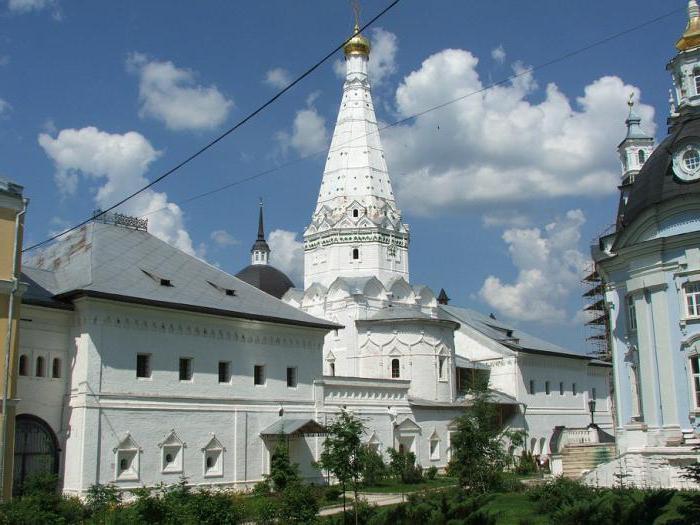For the first time about the village of Golyanovo is mentioned in documents dated to the 60s of the XVII century. The settlement got its name thanks to a small minnow fish, which at that time was found in abundance in the local reservoirs. Then Golyanovo belonged to Tsar Alexei Mikhailovich Romanov. An old Khomutovskaya road ran through the village, which led directly from Moscow to the grand-ducal apiary, located on the banks of the Klyazma River.
Construction
Around the same time, the wooden church of Zosimus and Savvaty, the miracle workers of Solovetsky, was erected. Presumably, its construction began on the orders of Tsar Alexei Mikhailovich himself. After its completion, the temple immediately began to receive maintenance from the neighboring village of Pokrovsky, and also tithe of mowing and the same amount of arable land came into its possession. It was on these incomes that the temple and its clergy were kept. In addition, soon a candle factory was also built in Golyanovo.
After the church of Zosima and Savvaty was built here, this settlement could no longer be treated as a village. From this moment, Golyanovo became a full-fledged village. It is known that this church was popular with parishioners, as it was visited not only by local residents, but also by peasants from nearby villages: Abramtsevo, Chernitsyno and Kobylino.
The construction of a new temple
Since 1765, the village of Galyanovo, together with neighboring villages, already belonged to the Palace Chancellery. Since this estate did not bring any income, at the beginning of the XIX century it was transferred to private ownership. In 1805, it was bought by a certain Sergeyev, and six years later, his adviser, Prince I.N. Trubetskoy, was already listed as his master. By the way, the estate of the latter included not only the village of Golyanovo, but also the surrounding villages, such as Sukovo, Abramtsevo, Lukino and Nikolskoye.
After the end of the war with Napoleon and the total looting by the French of the Trubetskoy estate in Govorov, the prince and his wife moved to Golyanovo. With their arrival in the village a new life began. The Trubetskoy estate began to transform literally before our eyes: a park was built around it and a large reservoir was created. From this moment, Golyanovo became considered the central estate of the Trubetskoys.
These transformations affected the church of Zosima and Savvatiy. In place of the old wooden temple, a new one was built of brick. It was consecrated in 1842. Princes Trubetskoy played a major role in the revival of the church, as they were the main contributors to the construction of the shrine.
Description
Initially, the new church of Zosima and Savvaty in Golyanovo was divided into two parts - winter and summer. The first of them consisted of a chapel, which included the refectory and the throne, dedicated to the holy great martyrs Natalya and Adrian. The cold part of the church consisted of a four with a throne, organized in honor of the Monks Savvaty and Zosima Solovetsky. A stone chapel now towered next to the new building.
The church of Zosima and Savvaty itself was built in the Empire Empire style, which was very fashionable at that time, dating back to late classicism. As already mentioned above, its refectory had only one aisle. And where the "Life-Giving Spring" is now located, a live key used to beat.
At the end of the XIX century, the Trubetskoy estate passed into the ownership of the Association of Balashikha manufactory. In 1872, a large allotment of over 2.5 thousand acres, which included the villages of Nikolskoye, Golyanovo and several other surrounding villages, was in the hands of the merchant A.N. Pribylov. The former formerly tsar's candle factory, now owned by the Moscow Diocesan Office, continued to manufacture its products here.
Rebirth
After the October Revolution, Golyanovo, like the whole country, was waiting for significant transformations that could not but affect the church of Zosima and Savvatiy. In the 30s, the temple was closed, and a pasta factory was placed in its premises. Only at the end of March 1990 he was finally returned to the Orthodox Church after many years of desecration and devastation. At that time, it was a dilapidated building.
In recent years, the temple has changed significantly. Now the church is completely renovated. On the territory of the shrine, a beautiful flower garden is broken, and in its center there is a fountain. A three-story Sunday school was built behind the church, which also houses a museum, in which sculptures and paintings are on display. In addition, the building has a conference room and a library. Now there is no trace of the former ruins, and the majestic bell tower, as once with its chime, again invites parishioners to the temple to glorify the Most High.
Church of Zosima and Savvaty of the Trinity-Sergius Monastery
It is known that the shrine in Golyanovo is not the only one dedicated to these Solovetsky miracle workers. There is another temple located on the territory of the Trinity-Sergius Monastery. This church was erected in the years 1635-1637. It was built simultaneously with stone chambers, which later housed a monastery hospital. According to an ancient inventory, initially the temple had five bells. Its harmonious and correct proportions, as well as the unusual decoration of the facade with a rather generous use of irrigated green tiles, made it one of the most interesting architectural monuments of the early XVII century.

The church of Zosima and Savvaty of the Trinity-Sergius Monastery was built with the active assistance of Alexander Bulatnikov, who was appointed by the Trinity cellar from among the monks of the Solovetsky monastery. Now it serves as the home church of the governor's chambers. In the rest of the complex of buildings, cathedral chambers are located, as well as the chambers of the governor of the laurel.